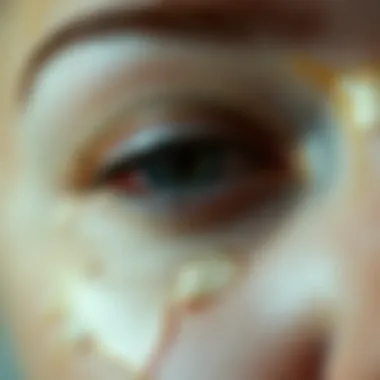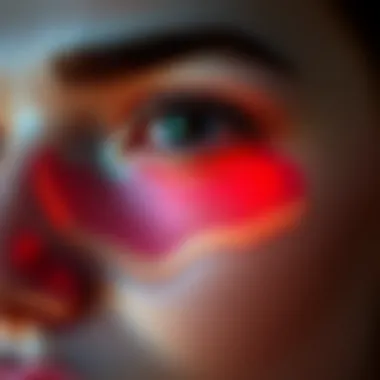Understanding Skin Peels: Insights for Under-Eye Care


Intro
When it comes to skincare, the area under the eyes often takes a backseat. Yet, it’s a prime spot that can reveal a lot about one’s health and well-being. Dealing with skin peels under this delicate area can be a frustrating experience, and many people may not realize that with proper attention, it can be effectively managed. This article aims to shed light on the ins and outs of skin peeling under the eyes, diving into its causes, the best treatments, and key preventive steps one should consider.
Insider Beauty Tips
Understanding the delicate skin beneath your eyes is essential for any beauty enthusiast. Let’s dive into a few crucial tips that can help maintain the skin's integrity and combat peeling.
Beauty Hacks
- Stay Hydrated: It's as simple as it sounds. Drinking enough water every day ensures that your skin retains moisture and stays plump.
- Humidifiers Are Your Friends: If you live in a dry climate, using a humidifier can be a game changer. This can add moisture back into the air and prevent your skin from drying out.
- Gentle Cleansing Routine: Soap can often strip moisture. Instead, use a gentle, hydrating cleanser to avoid irritating the skin under your eyes.
Skincare Tips
- Use Eye Creams with Peptides: These ingredients can help in rebuilding and repairing skin, which is beneficial for areas prone to peeling. Look for brands like Neutrogena or CeraVe, which have reputable formulations.
- Exfoliate Wisely: While exfoliating can be beneficial, it's best to do this sparingly in the under-eye area to avoid aggravating peeling skin. Opt for gentle exfoliation methods, possibly using products that include lactic acid or glycolic acid.
Haircare Secrets
Believe it or not, your hair products can affect your skin! Make sure that any creams or oils you use on your hair do not come into contact with your face, particularly the eye area. "No-brainer" but easy to overlook!
Causes of Skin Peels Under the Eyes
Skin peeling under the eyes can occur due to a variety of factors. Some common culprits might include:
- Allergic Reactions: These can be triggered by skincare or makeup products.
- Skin Conditions: Conditions such as eczema or psoriasis can manifest symptoms in this area.
- Environmental Factors: Cold weather or sun exposure can take a toll on delicate skin.
Suitable Treatments
When it comes to treating peeling skin, the approach should be both gentle and effective. Following are some recommended treatments:
- Moisturizing Ointments: Such as petrolatum jelly can create a barrier that helps retain moisture.
- Hydrating Masks: Look for masks that are specifically formulated for the eye area, such as those containing hyaluronic acid.
- Consult a Dermatologist: In cases where the peeling is persistent, seeking professional advice can uncover underlying conditions that may require specific treatments.
Preventative Measures
To avoid future incidents of peeling under the eyes, consider these proactive steps:
- Find the Right Products: Opt for fragrance-free moisturizers and eye creams that won’t irritate sensitive skin.
- Sun Protection: Use sunscreen daily around the eyes, particularly if you spend time outdoors.
- Be Mindful of Ingredients: Avoid harsh retinoids or alcohol-based products that can exacerbate dryness.
"Prevention is better than cure." Regularly monitoring your skincare routine will help in maintaining skin health under your eyes.
Prolusion to Skin Peels
Skin peeling can feel like a complex topic, especially when it comes to the delicate area underneath the eyes. Many individuals often overlook this region during skincare routines, but understanding skin peels and their implications is vital, especially for beauty enthusiasts. The skin under the eyes can bear the brunt of environmental stressors, making it susceptible to various conditions that may prompt peeling.
When we talk about skin peels, we’re not just looking at a superficial issue. Peeling skin can hint at deeper physiological concerns, signaling moisture loss or even allergic reactions. As we’re likely aware, the skin has its own way of communicating distress. Ignoring this can lead to more serious problems down the line.
Furthermore, promoting healthy practices concerning skin peels can lead to improved overall skin health. Implementing proper care can boost self-esteem and enhance one’s aesthetic presence. The nuances of skin care—balancing hydration and protection—can create a significant difference in one’s routine. It��’s not merely about aesthetics; it’s about nurturing the skin for long-term vitality.
There’s also the aspect of education. This article provides insight into the intricacies of skin peeling under the eyes, equipping readers with knowledge to tackle both prevention and treatment effectively. Understanding the reasons behind this phenomenon can spark a proactive approach to care. After all, knowledge is power, especially when it comes to achieving radiant skin.
In this guide, we will consider various aspects, starting from definitions of skin peeling to the unique features of the skin underneath the eyes, potential causes, best treatments, and preventive measures.
"The eyes are the window to the soul, and taking care of the skin around them is paramount to expressing your true self."
Addressing skin health doesn’t just involve applying products; it’s about fostering awareness and forming habits that support the skin's function. We’ll unravel every important point throughout this piece to shine a light on skin peels, understanding their implications in our beauty regimen.
The Skin Under the Eyes
Understanding the skin under the eyes is crucial in the broader conversation of skin care, especially since this delicate area can often fall victim to various issues, including peeling. The skin here is thinner and more sensitive compared to other parts of the face, making it prone to damage and requiring special attention. By comprehensively exploring this topic, we can better appreciate how to maintain its health and aesthetics.
This section will cover different aspects of the anatomy and unique characteristics of the periorbital skin, helping to underline its significance in skin health discussions. For beauty enthusiasts, this knowledge not only enhances daily care routines but also empowers them to choose effective treatments confidently.
Anatomy of the Under-Eye Area
The under-eye area comprises several key anatomical features that make it distinct. To start with, the skin is about 40% thinner than the rest of the facial skin. This fact alone highlights how vulnerable it is to external factors like environmental pollutants, aging, and dehydration.


Key components of this region include:
- Orbicularis Oculi Muscle: This circular muscle encircles the eye and is responsible for blinking and various facial expressions.
- Tarsal Plates: Providing structure to the eyelid, these help in the distribution of the tears over the eye surface.
- Fat Pads: These cushion the eye area but can become saggy or shift due to aging.
Moreover, the under-eye skin has fewer oil glands and less collagen, which contributes to its propensity to dryness and peeling. Recognizing these elements can help individuals tailor their skincare approaches to better suit these unique anatomical features.
Unique Characteristics of Periorbital Skin
When discussing the periorbital skin, several unique characteristics stand prominent:
- Delicacy: The thinness makes it more susceptible to irritants and requires around-the-clock care.
- Pigmentation: Variations in melanin distribution can lead to dark circles, a common issue linked to skin peeling.
- Vascularization: The high density of blood vessels in this area can cause the skin to appear more red or inflamed.
Because of its distinct traits, skincare products designed for the rest of the face are not always effective for the under-eye area. Using products specially formulated for this sensitive region is advisable. Moisturizers rich in hyaluronic acid can provide necessary hydration without being overly greasy, while gentle creams containing peptides may help counteract thinning skin.
"Understanding the unique qualities of the skin under the eyes can help you make better choices in your skincare routine, drastically reducing issues like peeling and irritation."
In summary, the skin under the eyes is not just another part of the face; it deserves meticulous attention and care. With its unique composition and vulnerabilities, acknowledging these factors leads to a more effective and preventive skincare approach.
Causes of Skin Peeling Under the Eyes
Understanding the causes of skin peeling under the eyes is crucial for tackling this often-neglected issue. This delicate skin area can reveal a lot about a person's overall health and wellness. Identifying the root causes helps guide effective treatments and prevention strategies. Additionally, recognizing these causes can empower individuals to take supportive measures in their daily routines. With proper knowledge, one can make informed decisions on skincare that truly benefits the sensitive area around the eyes.
Environmental Factors
Sun Exposure
Sun exposure is a major player in the game of skin health. The skin under the eyes is thinner and more sensitive than the rest of the face. Continuous exposure to the sun's harsh rays can lead to both immediate and long-term damage, such as peeling. UV radiation breaks down collagen and elastin, leading to reduced skin elasticity. While getting a dose of sunlight is beneficial for vitamin D production, it's important to protect the under-eye area with sunscreen. The key characteristic of sun exposure is its intensity and ability to cause not just cosmetic issues, but deeper skin damage over time. In this article, understanding sun exposure provides readers with the knowledge to embrace safer sun practices, which benefit overall skin integrity.
Pollution
Pollution is another sneaky culprit that can wreak havoc on the under-eye area. Daily exposure to pollutants like smoke, dust, and industrial chemicals contributes to skin irritation and inflammation. The under-eye skin, being delicate, is particularly vulnerable to these environmental aggressors. The unique feature of pollution is its cumulative effect on skin health; the more we expose ourselves to polluted environments, the more pronounced the damage can become. Through this discussion, readers gain awareness of how they can minimize exposure through practical steps, such as choosing cleaner environments and using protective products.
Climate Conditions
Climate conditions play a notable role in skin health, too. Extreme weather—be it cold, dry air or high humidity—can affect the skin's barrier function. Check it out; harsh winds and dry climates can pull moisture from the skin, leading to peeling. Conversely, humid climates can cause sweat and oil buildups, triggering irritation. Recognizing how climate impacts skin condition allows readers to adjust their skincare routines. For example, applying heavier creams in winter or using light gels in summer can help maintain hydration, making understanding climate conditions essential for effective skincare.
Skin Conditions
Eczema
Eczema is a common skin condition that can manifest under the eyes. It often presents as red, inflamed, or peeling skin, particularly in sensitive areas. The key characteristic of eczema is its itchy nature, which often leads to scratching and further irritation. In this article, discussing eczema provides insight into how to manage flare-ups effectively. Understanding eczema helps in recognizing triggers and selecting suitable, medical-grade treatments to alleviate discomfort and promote healing.
Psoriasis
Psoriasis, often known for its distinct scaly patches, can also affect the under-eye area. While less common than eczema in this zone, it can occur and lead to significant discomfort. The distinctive aspect of psoriasis is its chronicity; it’s a long-term autoimmune condition that tends to cycle through flare-ups and remissions. Covering psoriasis in this article raises awareness about what to look for and when to seek medical advice. Being informed can encourage individuals to pursue tailored treatment options that suit their needs.
Seborrheic Dermatitis
Seborrheic dermatitis features red, flaking skin, particularly in oily areas like the scalp and face, including around the eyes. This condition can cause peeling and irritation, making understanding seborrheic dermatitis vital for skincare enthusiasts. The unique feature of seborrheic dermatitis is its association with yeast overgrowth on the skin, which can be exacerbated by stress or hormonal changes. Discussing this condition allows readers to pinpoint potential aesthetic concerns and get timely advice on treatment and lifestyle adjustments that may lessen symptoms.
Allergic Reactions
Cosmetic Ingredients
Cosmetic ingredients are a double-edged sword. While they help enhance beauty, they can also lead to allergic reactions, especially in sensitive areas like the eyes. This temporary reaction can manifest as redness, swelling, or even peeling. The main takeaway here is the significance of knowing one’s skin type and being cautious with new products. Understanding the risks associated with certain ingredients can empower individuals to choose carefully and avoid adverse reactions that lead to skin peeling.
Environmental Allergens
Environmental allergens such as pollen, dust mites, and pet dander can trigger skin irritation that results in peeling. The key characteristic of environmental allergens is their ubiquitous nature—they can be found virtually anywhere, influencing individuals regardless of the season. This article emphasizes the importance of recognizing these triggers and suggests practical ways to limit exposure. By being proactive in assessing one’s environment, readers can mitigate the impact of allergens on their skin health.
Lifestyle Factors
Dehydration
Dehydration can lead to dry, flaky skin under the eyes. The lack of adequate water intake exacerbates the skin's condition, leading to peeling. This crucial aspect highlights how hydration affects not just the overall health but also skin vitality. Educating readers on the benefits of drinking enough water can potentially lead to improved skin appearance. In this article, the link between hydration and skin health serves as a wake-up call for many.


Poor Nutrition
Nutritional deficiencies can manifest in the skin, causing it to peel. Diets low in essential fatty acids, vitamins, and minerals may mean the under-eye area suffers. The key characteristic is that what you consume directly reflects on your skin health. This article aims to bring attention to the importance of a balanced diet rich in nutrients. Promoting such dietary changes can be a simple yet effective way to enhance skin resilience.
Lack of Sleep
A lack of sleep can lead to all sorts of skin woes, including dark circles and peeling skin. The under-eye area, being particularly susceptible to fatigue's effects, often shows signs of stress and exhaustion. Discussing lack of sleep allows readers to grasp its impact on skin health and understand the importance of rest. This section motivates individuals to prioritize sleep, thereby fostering healthier skin outcomes.
Treatments for Peeling Skin Under the Eyes
Dealing with peeling skin under the eyes can be a hassle. It’s that pesky issue often ignored until it’s glaring but can be indicative of a larger concern. The skin in that area is distinctively delicate, making proper treatments paramount. Finding effective solutions aids not only in restoring the skin but also in boosting confidence. This section covers topical treatments and professional procedures that cater specifically to this sensitive zone.
Topical Treatments
Hydrating Creams
Hydrating creams are a go-to for many concerned about dryness. They do wonders for that thin skin beneath the eyes, enveloping it in moisture and preventing further peeling. The remarkable quality of these creams lies in their formulation, which usually includes ingredients like hyaluronic acid, glycerin, and essential oils. These components work in tandem to draw water into the skin and keep it locked in place.
The appeal of hydrating creams is their accessibility; they are widely available and many are formulated specifically for the under-eye area. However, users must be mindful of the ingredients. Some products may contain fragrances or alcohols that could exacerbate sensitivity. Alongside their benefits, it’s worth weighing the downside of potential irritants that can reverse the hard-won results.
Corticosteroids
Corticosteroids can be a strong ally when inflammation plays a role in under-eye peeling. These topical steroids are effective in managing redness, itching, and swelling. The major strength of corticosteroids is their potent anti-inflammatory properties, which can quickly alleviate irritation.
Despite their efficacy, these creams must be used with caution. Prolonged use, especially on such a delicate area, can lead to thinning of the skin. So, while they can provide significant temporary relief, ongoing use should be monitored closely, often under the guidance of a healthcare professional.
Prescription Treatments
For more persistent cases, prescription treatments may be a necessary route. These options can include stronger topical medications that offer a focused approach to underlying conditions causing the peeling. The key characteristic of these treatments is that they are tailored, based on a thorough evaluation by a dermatologist, which sets them apart from over-the-counter solutions.
However, the access issues often arise from the requirement of a physician’s consultation, making them less convenient for some individuals. Moreover, users must be mindful of possible side effects, as stronger formulas may not suit everyone. It's crucial to have an open dialogue with a healthcare provider regarding these risks.
Professional Procedures
Chemical Peels
Chemical peels target more profound layers of skin, aiding in rejuvenation and peeling issues. They utilize various acids to exfoliate and promote skin renewal. A key feature is the personalized nature of these peels; professionals can adjust the strength based on individual skin needs.
One of the significant advantages of chemical peels is their efficiency; they can yield quick and visible results after just one session. However, aftercare is crucial, as the skin often requires protection and nurturing post-treatment. Some may also experience redness or peeling immediately after, making it imperative to follow the provided instructions.
Laser Treatments
Laser treatments bring forth a modern approach to address skin concerns effectively. By using precise light beams, these procedures enhance collagen production and improve skin texture. Their appeal stems from their dual ability to treat existing issues while promoting overall skin health.
Yet, they come with a higher price tag and require a reputable specialist for best results. Furthermore, not every individual is a candidate, and it’s essential to discuss potential risks beforehand. Just as with any powerful treatment, the balance between reward and risk holds critical significance.
Engaging with the right treatments can pave the way for healthier skin under the eyes. Every choice must consider the unique needs of the skin in this delicate area.
Tailoring treatments appropriately according to skin types and peeling causes is pivotal in overcoming these bothersome issues. The understanding gained here equips readers with tools to make informed decisions.
Preventing Skin Peeling Under the Eyes
Preventing skin peeling under the eyes is a crucial aspect of maintaining overall skin health. When the delicate skin beneath our eyes peels, it can be both uncomfortable and unsightly. Regular preventative measures can go a long way in ensuring that this sensitive area remains hydrated and protected. This article covers various strategies, including proper routines, dietary considerations, and protective measures that can help keep skin peeling at bay.
Daily Care Routines
Proper Cleansing
Cleansing is essential in any skincare regime, especially for the area under the eyes. It sets the foundation for healthier skin by removing impurities and excess oils that can clog pores. Using a gentle cleanser specifically designed for sensitive areas like the eyes ensures that you’re not stripping away essential moisture. The key point here is mildness; overloading this area with harsh scrubs can lead to more irritation—even peeling.
Furthermore, a unique feature of proper cleansing is its focused approach to hydration. Cleansers with hydrating properties, often containing ingredients like hyaluronic acid or aloe vera, will help keep the skin moist. While it’s tempting to opt for traditional soaps or any regular face wash, they might not be the best for thin under-eye skin.
Moisturizing Techniques
Moisturizing techniques play a pivotal role in preventing peeling by locking in hydration. A good moisturizer not only hydrates but also reinforces the skin barrier—something especially important for the under-eye area, which is thinner compared to the rest of the face. Products rich in ceramides and glycerin are often recommended due to their ability to attract moisture.


The beauty of a tailored moisturizing technique lies in its application method. Gently tapping the cream into the skin with your ring finger can stimulate blood flow without causing undue stress to the area. While many lotions might promise results, understanding how to apply them correctly enhances their efficacy.
Dietary Considerations
Hydration
Hydration is a cornerstone of effective skin care. The skin under the eyes can suffer significantly from dehydration, leading to flakiness and irritation. This links to overall body hydration, meaning drinking adequate water is paramount. Water acts as a natural moisturizer, providing the skin with essential support from within.
What sets hydration apart is its direct impact on skin elasticity. Well-hydrated skin is more resilient and less susceptible to peeling. A simple way to ensure proper hydration is infusing water with fruits or herbs, making it not only palatable but visually appealing as well.
Nutrient-Rich Foods
Consuming nutrient-rich foods is another essential element in the fight against skin peeling. Foods packed with vitamins A, C, E, and omega fatty acids contribute positively to skin health. For example, avocados and nuts are excellent options that help in creating a resilient skin barrier.
The unique feature of nutrient-rich foods is their holistic approach. They not only assist in external skin repair but nurture the skin from inside out, addressing issues before they manifest. Opting for whole, unprocessed foods over sugary snacks can make a significant difference in skin appearance.
Protective Measures
Sunscreen Application
Sunscreen application is a non-negotiable aspect of skin health, particularly for the area around the eyes. UV rays can cause damage leading to peeling, premature aging, and even skin cancer. A broad-spectrum sunscreen with at least SPF 30 should be applied daily, even on cloudy days.
A notable characteristic of good sunscreen is its non-irritating formulation designed for use around the eyes. Mineral-based options, containing titanium dioxide or zinc oxide, offer excellent protection while minimizing potential irritation, which is critical for sensitive skin. However, neglecting to apply it consistently can leave the skin vulnerable, making it a must-do in any skincare routine.
Eye Protective Accessories
Using eye protective accessories can further bolster your defense against skin peeling. Shades, for instance, not only make a fashion statement but provide a physical barrier against harmful rays and environmental elements. Plus, hats can also offer shade and protection from both UV exposure and irritants.
The beauty of protective accessories is their versatility; they complement any skincare regime. However, the downside may be an initial investment in quality products, which might not fit everyone’s budget. Investing in good quality protective gear can reduce the need for extensive skin treatments in the long run.
Consulting Professionals
Seeking professional guidance regarding skin peels under the eyes can be a real game-changer in maintaining skin health. Many often overlook the subtleties of their skin conditions, assuming that some home remedies or over-the-counter products might suffice. However, in the delicate region under the eyes, what may seem like a minor annoyance could be a symptom of a more significant issue. Consulting a professional, like a dermatologist, provides tailored insight and effective treatment options that can be beneficial in the long run.
When it comes to skin peeling under the eyes, a professional can help identify if the cause is due to an underlying skin ailment, an allergic reaction, or simply a need for a more informed skincare routine. Getting expert advice not only gives peace of mind but also saves time and potential aggravation from trial-and-error approaches.
When to Seek Help
It's crucial to know when your skin's response calls for a professional's touch. If you notice persistent peeling, it might be a sign to hang up the DIY towel. Here are some indicators that you should consider getting a professional opinion:
- Persistent Symptoms: If peeling lasts more than a week despite trying home treatments, it may be time to see a dermatologist.
- Severe Irritation: Redness, swelling, and itchiness are red flags that shouldn't be ignored. They may suggest an infection or chronic skin condition.
- Changes in Skin Texture: An increase in dryness, flakiness, or any form of unusual texture can hint at deeper skin issues.
- Allergies or Reactions: If you've recently tried new products and experienced peeling, professional diagnosis might be necessary to prevent further irritation.
Remember: Early intervention often leads to better results. Don’t wait until the problem escalates.
Finding the Right Dermatologist
Choosing the right dermatologist can make all the difference in your skin health journey. Look for someone who specializes in cosmetic dermatology or has experience in treating concerns related to the periorbital area. Here are some tips to find that fitting experience:
- Check Qualifications: Confirm if the dermatologist is board-certified and has a good reputation. You can take a peek at sites like Healthgrades for reviews.
- Specialization: Since your focus is on skin peeling under the eyes, look for a dermatologist who has handled similar cases or who specializes in skin aesthetics.
- Consultation: Before committing, consider scheduling an initial consultation to gauge their approach. A good dermatologist will listen to your concerns and provide clear guidance aligned with your skin health goals.
- Referrals and Reviews: Personal referrals can be invaluable. Ask friends or family for recommendations or check online forums such as Reddit for personal experiences.
In short, consulting professionals not only helps in treating current issues but also equips you with the knowledge to prevent future problems. Embracing a better skin health routine is a journey, and the right dermatologist will be an essential partner in that process.
End
By summarizing the causes, treatments, and preventive strategies highlighted, we bring to light the importance of a gentle yet effective skin regimen. Peeling skin under the eyes might often be dismissed as a minor issue, but it can signal underlying health problems that may warrant attention. Hence, this article aims to empower readers with knowledge, motivating them to take proactive steps for achieving skin health.
Understanding the factors that contribute to skin peeling, from environmental elements to lifestyle choices, gives beauty enthusiasts the ability to adapt their routines accordingly. Moreover, the insight into treatments—including both at-home remedies and professional options—equips readers with a broader perspective to deal with specific skin concerns. The more educated an individual is about their skin, the better prepared they are to tackle challenges such as peeling skin.
Ultimately, awareness is the first step to effective skin care. Readers should feel inspired to actively engage in their skincare journey, embracing practices that promote health rather than simply beauty. Knowing when to consult with professionals reinforces the notion that skin health is paramount, adding another layer of care to your regimen.
"The key to maintaining skin health is being attentive to changes and responsive to your skin's needs."
Summary of Key Points
- Importance of Understanding Skin Health: Knowledge helps in recognizing and addressing skin conditions effectively.
- Recognizing Causes of Skin Peeling: Factors such as environmental issues, skin conditions, allergens, and lifestyle choices can lead to peeling.
- Treatments Available: Options range from topical creams to professional procedures, each serving specific needs.
- Prevention: Daily routines, diet, and protective measures are vital for skin maintenance.
- Consultation with Professionals: Knowing when to seek help ensures that underlying issues are properly managed.
Encouragement for Skin Health Awareness
Emphasizing skin health awareness is essential. Regular monitoring of your skin allows for early detection of possible issues. Establishing a consistent skincare routine, enriched with the right products, not only combats peeling but enhances the overall appearance and resilience of the skin. Knowledge fosters empowerment; equipping your routine with facts allows for informed decisions that can lead to healthier skin.
Additionally, sharing these insights within communities—whether through social media or skincare enthusiasts' forums—can help others who might be dealing with similar issues. Discussions about skincare should be open, sharing personal experiences, remedies, or products that have made a difference can turn into valuable resources for all.
In summary, skin health isn't just a trend; it's a commitment to personal well-being. Approach it with curiosity and care, and let it evolve with your journey.







